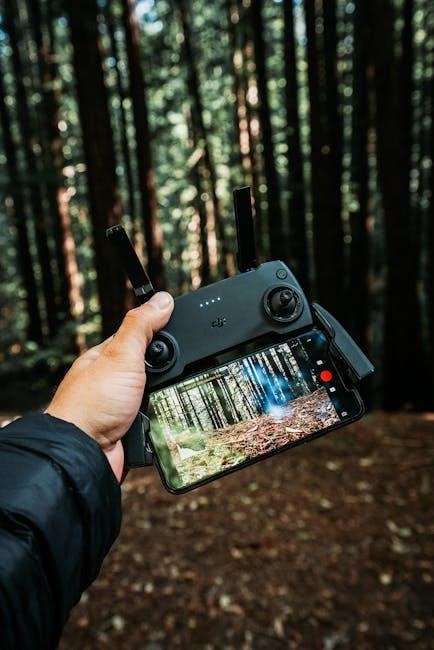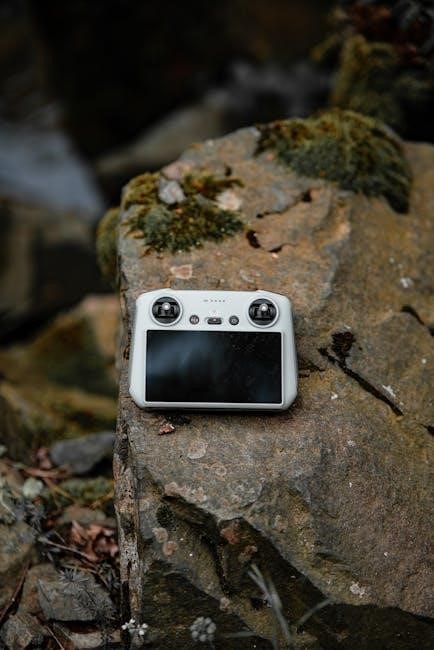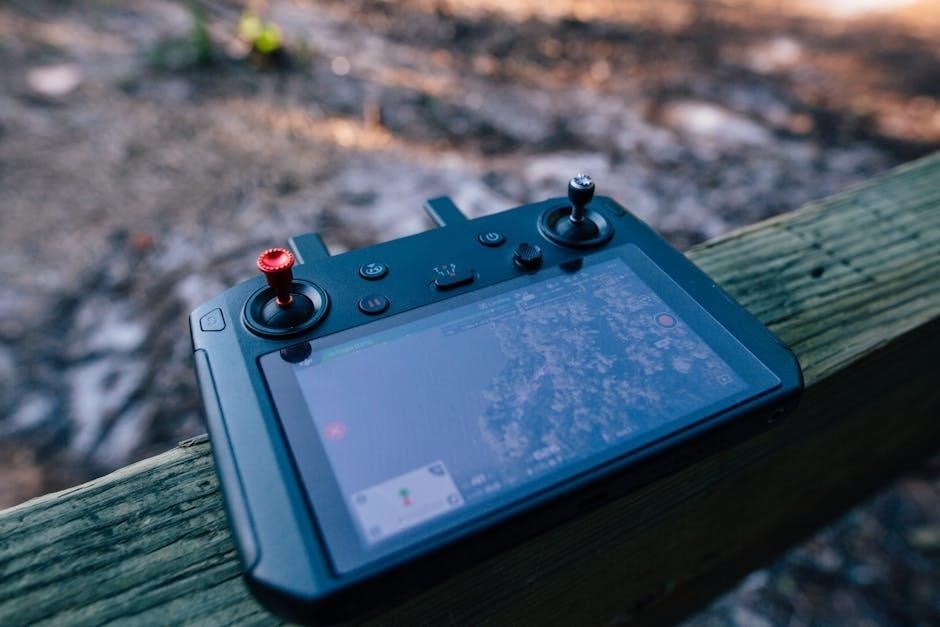Learn how to effectively use and program RF wireless remote LED controllers for seamless lighting control. Discover pairing, programming, and operating tips for optimal performance and convenience.
Overview of RF Wireless Technology in LED Controllers
RF (Radio Frequency) wireless technology enables seamless control of LED lighting systems without physical connections. Operating on frequencies like 433/434 MHz, it ensures reliable communication between remotes and controllers. The technology eliminates line-of-sight requirements, allowing signals to penetrate walls and obstacles. This makes it ideal for home automation, offering convenience and flexibility. RF modules simplify installation and provide consistent performance, making them a popular choice for LED strip control systems. They also support advanced features like color changing and dynamic modes, enhancing user experience.
Importance of Proper Setup and Programming
Proper setup and programming are crucial for optimal functionality of RF wireless LED controllers. Correct pairing of remotes and controllers ensures reliable communication, while accurate programming customizes lighting effects and prevents interference. Following step-by-step instructions guarantees consistent performance and avoids operational issues. Additionally, troubleshooting steps like power cycling or resetting controllers can resolve common problems. Investing time in proper configuration ensures seamless control, enhances user experience, and maximizes the potential of your LED lighting system for long-term reliability and satisfaction.

Understanding the Components of the RF Wireless Remote LED Controller
The system includes a remote control, receiver module, and LED strips. The remote transmits RF signals, while the receiver decodes them to control lighting. Proper connections and configurations ensure reliable operation and customization;
Hardware Components: Remote, Receiver, and LED Strips
The RF wireless remote LED controller system consists of three main hardware components: the remote control, the receiver module, and the LED strips. The remote control sends radio frequency signals to the receiver, which decodes and executes commands. LED strips are connected to the receiver and respond to brightness, color, and mode adjustments. The remote typically uses a 3V CR2025 battery, ensuring reliable operation. These components work together seamlessly to provide wireless control over lighting systems, with compatibility for both single-color and RGB LED strips.
Power Requirements and Electrical Connections
The RF wireless remote LED controller system requires a stable power supply to operate efficiently. The remote control typically uses a 3V CR2025 battery, while the LED strips and receiver are connected to a DC power supply, usually 12-24V. Ensure proper electrical connections by wiring the receiver to the power supply and LED strips according to the manufacturer’s instructions. Secure connections are crucial for reliable operation. Always disconnect power before making adjustments to avoid electrical hazards.

Pairing the RF Remote with the LED Controller
Pairing the RF remote with the LED controller ensures seamless communication. Plug in the controller, press specific buttons within seconds, and sync the remote for reliable operation.
Step-by-Step Pairing Instructions for Single LED Strips
Ensure the LED strip and controller are powered off.
Plug in the controller and wait 5-10 seconds.
Press and hold the remote’s Speed and Speed- buttons together.
The LED strip will confirm pairing by lighting up or blinking.
Release the buttons and test the remote functions to ensure connectivity. This process syncs the remote with the controller for single LED strip control.
Pairing Multiple LED Strips with One Remote
Power off all LED strips and controllers.
Plug in the first LED strip and controller, then the second, ensuring they are connected to the same power source.
Press the remote’s pairing button or hold specific keys (like Speed and Speed-) for 5-10 seconds to enter pairing mode.
Repeat for each LED strip, syncing them individually with the remote.
Test the remote to ensure all strips respond simultaneously. This method allows one remote to control multiple LED strips seamlessly.

Programming the RF Wireless LED Controller
Program your RF wireless LED controller by connecting it to power, pressing specific buttons to sync with the remote, and adjusting settings for single-color or RGB strips.
Programming Single-Color LED Strips
Connect the RF wireless LED controller to a 12-24V DC power supply. Ensure the LED strip is properly linked to the controller. Press and hold the Speed+ and Speed- buttons simultaneously for 5-10 seconds to enter programming mode. Use the remote to adjust brightness and verify functionality. Once programmed, the LED strip will respond to remote commands for on/off and dimming. Ensure all connections are secure for reliable operation. If issues arise, check power connections and repeat the programming process as needed.
Programming RGB LED Strips for Color Changing
To program RGB LED strips, connect the controller to a 12-24V DC power source. Enter programming mode by pressing and holding the Speed+ and Speed- buttons for 5-10 seconds. Use the remote to cycle through colors and select your desired hue; Adjust brightness using the dimmer buttons. Save settings by turning the controller off and on again. Ensure the LED strip is properly connected to the controller for smooth color transitions and reliable operation; Test all functions to confirm programming success.

Operating the RF Wireless Remote LED Controller
Operate your RF wireless remote LED controller effortlessly. Turn LEDs on/off, adjust brightness, and explore advanced features like color changing and dynamic modes seamlessly.
Basic Functions: Turning On/Off and Adjusting Brightness
The RF wireless remote LED controller offers straightforward operation. Press the designated power button to turn the LED strips on or off. Adjust brightness seamlessly using the dimmer buttons. The remote signal works without line-of-sight, ensuring reliable control. Simply press and hold the brightness adjustment buttons to increase or decrease light intensity. These basic functions provide easy and efficient control over your LED lighting system, enhancing convenience and user experience.
Advanced Functions: Color Selection and Dynamic Modes
The RF wireless remote LED controller offers advanced functions like color selection and dynamic modes. Users can seamlessly switch between various colors using the remote’s designated buttons. Dynamic modes allow for automatic color transitions, creating vibrant lighting effects. These features enhance the LED lighting experience, providing flexibility and creativity for different settings. The remote’s intuitive design makes it easy to access and customize these advanced functions, ensuring a personalized and dynamic lighting environment.

Installation and Wiring Tips
Ensure proper installation by connecting power supplies securely and wiring LED strips correctly. Avoid short circuits and use insulated wires for safe connections. Mount the receiver in an open area for optimal signal strength, and keep wiring organized to prevent interference. Follow these tips for a reliable and efficient setup.
Wiring the LED Controller to the Power Supply
Connect the LED controller to a compatible power supply (12-24V DC) using the provided terminals or wires. Ensure correct polarity by matching positive and negative terminals. Secure connections tightly to avoid loose wiring. Use insulated wires to prevent short circuits and electrical hazards. Double-check voltage requirements to match your LED strip specifications. Avoid overloading the power supply, and ensure adequate ventilation for heat dissipation. Proper wiring ensures reliable operation and extends the lifespan of your LED lighting system.
Mounting the Remote and Receiver for Optimal Range
Mount the RF remote and receiver in open areas to maximize signal strength. Place the receiver centrally to cover the entire space. Avoid obstacles like walls or metal objects that can block the signal. Ensure the remote is within the recommended range (typically up to 20 meters). Keep devices away from other wireless electronics to minimize interference. Secure both units firmly to prevent movement or vibration. Proper placement ensures reliable connectivity and consistent control over your LED lighting system.

Troubleshooting Common Issues
Troubleshoot issues like the remote not responding, LED strips not lighting, or flickering. Check connections, ensure proper pairing, replace batteries, verify signal strength, and reduce interference from other devices.
Remote Not Responding to Commands
If the remote isn’t responding, ensure the battery is fresh and properly installed. Check for physical obstructions between the remote and receiver. Verify the remote is paired correctly with the controller. Press buttons firmly to ensure signals are sent. If issues persist, reset the controller by unplugging and replugging it. Ensure the receiver is functioning and within range. Replace the battery if necessary. Advanced troubleshooting may involve re-pairing the remote or checking for interference from other devices.
LED Strips Not Lighting Up or Flickering
If LED strips aren’t lighting up or flicker, check the power supply connections and ensure the voltage matches the strip’s requirements. Verify the remote is paired correctly and the receiver is functioning. Inspect wiring for loose connections or damage. Flickering may indicate interference from other devices; try moving the receiver or using a signal booster. Reset the controller by unplugging and replugging it. If issues persist, re-pair the remote with the controller or replace faulty components. Ensure all electrical connections are secure and free from corrosion.

Optimizing the Range of the RF Wireless Signal
Ensure optimal placement of the remote and receiver, minimizing obstructions. Use signal boosters if necessary to enhance coverage and reduce interference for a stable connection.
Factors Affecting RF Signal Strength
Physical obstructions like walls and furniture can weaken RF signals. Interference from other wireless devices operating on similar frequencies may also disrupt connectivity. Distance between the remote and receiver plays a crucial role, as signals weaken over longer ranges. Additionally, metal objects or electrical interference from nearby appliances can impede signal strength, reducing the overall performance of the RF wireless system. Ensuring a clear line of sight and minimizing interference sources can help maintain a stable connection.
Improving Signal Coverage and Reducing Interference
To enhance RF signal coverage, ensure the remote and receiver are positioned optimally, minimizing physical obstructions. Use high-quality antennas to boost signal strength and range. Regularly updating firmware and using interference-reducing devices can help mitigate disruptions. Placing the receiver in a central location and avoiding nearby wireless devices operating on similar frequencies further improves reliability. These steps ensure a stable and interference-free connection for smooth operation of your LED lighting system.
Safety Precautions and Best Practices
Always disconnect power before handling electrical components to prevent shocks. Avoid overloading circuits and ensure proper ventilation to prevent overheating. Handle devices with care and use protective gear when necessary.
Handling Electrical Components Safely
Always disconnect power before working with electrical components to avoid shocks. Use protective gear like gloves and safety glasses. Ensure components are cool to prevent burns. Never overload circuits, as this can cause overheating or fires. Keep electrical parts away from water and moisture to prevent short circuits. Properly insulate wires and connections to avoid electrical hazards. Follow manufacturer guidelines for handling LED strips, remotes, and controllers. Regularly inspect devices for damage and replace faulty components immediately to ensure safe operation.
Avoiding Overheating and Electrical Hazards
To prevent overheating, ensure proper ventilation around LED controllers and avoid overloading circuits. Keep all components away from flammable materials. Regularly inspect wires and connections for damage or wear. Avoid exposing electrical parts to moisture, as this can cause short circuits. Do not operate devices near water or in humid environments. Use surge protectors to safeguard against voltage spikes. Always follow manufacturer guidelines for power ratings and installation to minimize electrical hazards and ensure safe, reliable operation of your RF wireless LED controller system.

Advanced Customization and Features
Explore custom codes for tailored functions, smart home integration, and dynamic lighting modes. Enhance your setup with advanced features for personalized control and seamless connectivity.
Using Custom Codes for Specific Functions
Custom codes enable tailored control over LED lighting, allowing users to assign specific functions to remote buttons. By entering programming mode, users can input unique codes to customize operations like channel assignment or brightness adjustment. This feature is particularly useful for advanced setups, ensuring precise control over lighting behaviors. The process typically involves connecting the controller to a power source, pressing a sequence of buttons within a set timeframe, and awaiting confirmation via an LED indicator or light blink, ensuring successful customization for enhanced functionality.
Integrating with Smart Home Systems
RF wireless LED controllers can seamlessly integrate with smart home systems, enhancing control and convenience. Many systems support these controllers, enabling voice commands and app-based adjustments for tailored lighting experiences. Compatibility varies, with some remotes lacking certain frequencies, so checking specifications is crucial. This integration allows for advanced automation and synchronization with other smart devices, offering a unified and efficient home experience.

Maintenance and Care
Regularly clean the remote and controller to ensure proper functionality. Replace batteries when needed and avoid exposure to moisture. Update firmware periodically for enhanced performance and reliability.
Cleaning the Remote and Controller
Regularly clean the remote and controller to maintain functionality. Use a soft, dry cloth to wipe surfaces. For stubborn dirt, dampen the cloth slightly but avoid liquids. Ensure no moisture enters openings. Clean battery compartments to prevent corrosion. Avoid harsh chemicals, as they may damage materials. Proper cleaning ensures reliable operation and extends lifespan. Regular maintenance prevents issues like button malfunctions or signal interference. Keep devices dry and store in a cool, dry place when not in use for optimal performance.
Updating Firmware for Enhanced Performance
Periodically update the firmware to enhance functionality and fix issues. Connect the controller to a computer using the provided cable. Download the latest firmware from the manufacturer’s website. Use the supplied software to upload the update. Ensure the controller is fully powered and avoid interruptions. After completion, restart the system. Updated firmware improves compatibility, adds features, and resolves bugs. Regular updates ensure optimal performance and maintain system efficiency. Always follow manufacturer instructions for a smooth update process.
By following these instructions, you’ve mastered the RF wireless remote LED controller system. Enjoy enhanced lighting experiences with optimal performance and seamless control of your LED setups.
Final Tips for Effective Use
Regularly check connections and battery levels to ensure smooth operation. Test the remote’s range and replace batteries annually for optimal performance. For complex setups, consult the manual or seek professional help. Keep firmware updated for enhanced features and security. Always label remote buttons for easy access and save custom codes for quick reprogramming. Proper maintenance ensures longevity and reliability of your RF wireless LED controller system, providing years of trouble-free lighting control and enjoyment.
Resources for Further Assistance
For additional guidance, refer to the official manufacturer’s website or user manual. Online forums and YouTube tutorials offer practical demonstrations. Contact customer support for specific issues. Visit electronics communities for troubleshooting tips. Many retailers provide detailed guides and FAQs. Ensure to use verified sources for accurate information. Regularly check for firmware updates and compatibility guides. Reach out to professional electricians for complex installations. Utilize online resources to explore advanced features and customization options for your RF wireless LED controller system.
